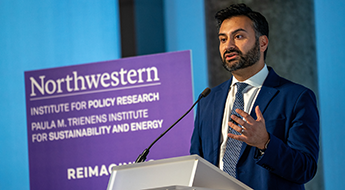How Families in the Top 0.1% Pass on Wealth to Their Children
New research explores how affluent families preserve their fortunes for future generations
Get all our news
In this context of ever-increasing wealth inequality, looking at how the kind of families with a lot of resources go about preserving and augmenting their wealth can teach us a lot about how inequality persists.”
Doron Shiffer-Sebba
IPR associate

As the gap continues to grow between the richest and poorest Americans, so does our fascination with the unattainable lifestyles of the ultrawealthy. In the award-winning show "Succession," inspired by the Murdoch family, viewers experience the opulent world of the mega-rich as the Roy siblings fight over who will take over their father Logan Roy’s media empire.
While the Roy family is fictional, the show astutely depicts how the interpersonal family dynamics of the wealthy are deeply intertwined with the legal entities that control their vast fortunes. At a family gathering to celebrate Logan’s 80th birthday in the show’s first episode, he blindsides his adult children, using the occasion to ask them to sign paperwork changing the terms of their family trust.
This dramatic moment draws on real-world practices explored in new research by sociologist and IPR associate Doron Shiffer-Sebba, who examines how the rich pass their wealth down across generations. Published in the American Sociological Review, the study shows that wealthy families create legal entities such as corporations, trusts, or foundations, and then adopt “bureaucratic practices” to hold onto their fortunes.
“In this context of ever-increasing wealth inequality, looking at how the kind of families with a lot of resources go about preserving and augmenting their wealth can teach us a lot about how inequality persists,” Shiffer-Sebba said.
To protect their money, he explains that rich families begin to resemble organizations. Family members are given formal roles in legal entities and receive specialized training from wealth management professionals to fulfill these roles. These professionals teach family members skills to actively participate in the legal entities that will help preserve their fortunes, like running meetings, giving presentations, and interpreting legal documents.
“These practices then help establish a kind of legal veneer that helps protect funds in cases of legal disputes,” he said, noting that threats to a family’s wealth could come from rogue family members, outsiders, or the government.
For six months, Shiffer-Sebba spent time at a family office, a specific kind of wealth management firm that worked with clients with a net worth of over $50 million. He observed and took notes during meetings and social outings with clients, focusing on two families that he calls the Breshnevs and the Martinos. He also interviewed one member of each of the firm’s client families and staff at 30 additional family offices to understand how common the patterns he observed were across offices.
“I was really expecting to just see professionals doing work to preserve and augment the wealth of their clients, but over and over again, I was surprised at just how much family member involvement there was,” Shiffer-Sebba said.
Some of those activities included documenting family trust meetings and reviewing documents. During one meeting, the Breshnev grandchildren—some younger than 13 years old—made formal presentations to their family’s foundation, petitioning for several thousand dollars to donate to a charity they wanted to support. This shows that preparing family members to participate in a trust or fund can begin very early.
As wealth inequality rises between the richest and poorest families in the United States, why do the activities of the wealthiest matter to the average American? Shiffer-Sebba explains that understanding these behaviors can provide opportunities to change policy that might reduce wealth inequality. For example, passing laws preventing people from serving in legal entities funded by a family member could make it more difficult to preserve large family fortunes.
“I'm trying to shine a light on these practices that are happening because I think they might be an easier avenue, frankly, for moving the needle on wealth inequality than things like fighting over the specific tax rates, which appear to be very hard to move the needle [on],” he said.
These family-run legal entities can have negative impacts on the rich, too. Shiffer-Sebba says people participating in these types of organizations can strain family relationships, which families don’t always anticipate.
Shiffer-Sebba is currently writing a book that expands on this study arguing that rich individuals have less freedom and power to use their money than popularly believed because it’s often tied up in their family’s legal entities. This may be key to unpacking why money stays concentrated among wealthy families.
“The fact that individual elites actually have less power than we might think, actually sustains wealth inequality even more, because it’s that lack of power that keeps the wealth stagnant at the top and doesn't provide any avenues for it to slip through the cracks, and, if you will, trickle down to other strata of society,” he said.
Doron Shiffer-Sebba is assistant professor of sociology and an IPR associate.
Photo credit: iStock
Published: May 16, 2025.


